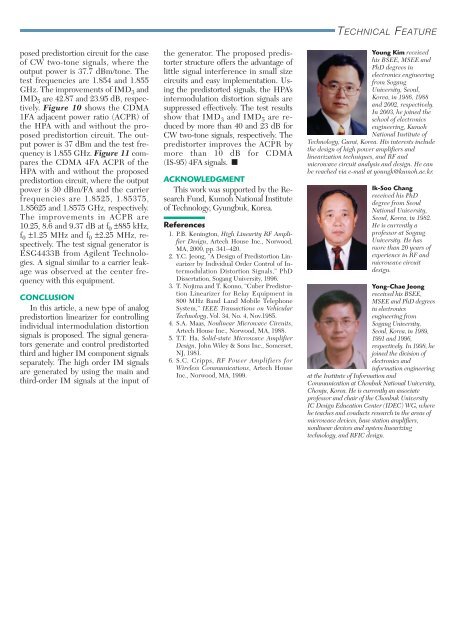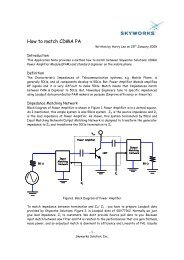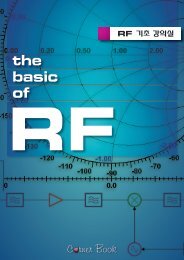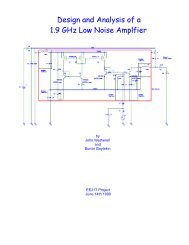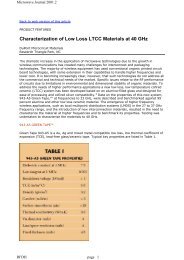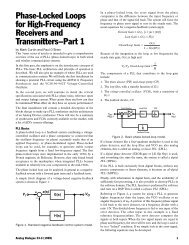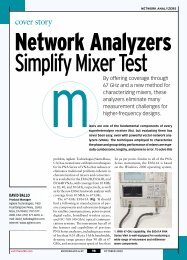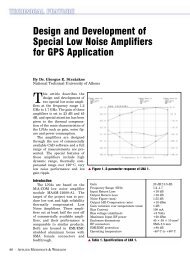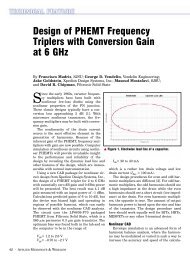AN ANALOG PREDISTORTION LINEARIZER DESIGN
AN ANALOG PREDISTORTION LINEARIZER DESIGN
AN ANALOG PREDISTORTION LINEARIZER DESIGN
Create successful ePaper yourself
Turn your PDF publications into a flip-book with our unique Google optimized e-Paper software.
posed predistortion circuit for the case<br />
of CW two-tone signals, where the<br />
output power is 37.7 dBm/tone. The<br />
test frequencies are 1.854 and 1.855<br />
GHz. The improvements of IMD 3 and<br />
IMD 5 are 42.87 and 23.95 dB, respectively.<br />
Figure 10 shows the CDMA<br />
1FA adjacent power ratio (ACPR) of<br />
the HPA with and without the proposed<br />
predistortion circuit. The output<br />
power is 37 dBm and the test frequency<br />
is 1.855 GHz. Figure 11 compares<br />
the CDMA 4FA ACPR of the<br />
HPA with and without the proposed<br />
predistortion circuit, where the output<br />
power is 30 dBm/FA and the carrier<br />
frequencies are 1.8525, 1.85375,<br />
1.85625 and 1.8575 GHz, respectively.<br />
The improvements in ACPR are<br />
10.25, 8.6 and 9.37 dB at f 0 ±885 kHz,<br />
f 0 ±1.25 MHz and f 0 ±2.25 MHz, respectively.<br />
The test signal generator is<br />
ESG4433B from Agilent Technologies.<br />
A signal similar to a carrier leakage<br />
was observed at the center frequency<br />
with this equipment.<br />
CONCLUSION<br />
In this article, a new type of analog<br />
predistortion linearizer for controlling<br />
individual intermodulation distortion<br />
signals is proposed. The signal generators<br />
generate and control predistorted<br />
third and higher IM component signals<br />
separately. The high order IM signals<br />
are generated by using the main and<br />
third-order IM signals at the input of<br />
the generator. The proposed predistorter<br />
structure offers the advantage of<br />
little signal interference in small size<br />
circuits and easy implementation. Using<br />
the predistorted signals, the HPA’s<br />
intermodulation distortion signals are<br />
suppressed effectively. The test results<br />
show that IMD 3 and IMD 5 are reduced<br />
by more than 40 and 23 dB for<br />
CW two-tone signals, respectively. The<br />
predistorter improves the ACPR by<br />
more than 10 dB for CDMA<br />
(IS-95) 4FA signals. ■<br />
ACKNOWLEDGMENT<br />
This work was supported by the Research<br />
Fund, Kumoh National Institute<br />
of Technology, Gyungbuk, Korea.<br />
References<br />
1. P.B. Kenington, High Linearity RF Amplifier<br />
Design, Artech House Inc., Norwood,<br />
MA, 2000, pp. 341–420.<br />
2. Y.C. Jeong, “A Design of Predistortion Linearizer<br />
by Individual Order Control of Intermodulation<br />
Distortion Signals,” PhD<br />
Dissertation, Sogang University, 1996.<br />
3. T. Nojima and T. Konno, “Cuber Predistortion<br />
Linearizer for Relay Equipment in<br />
800 MHz Band Land Mobile Telephone<br />
System,” IEEE Transactions on Vehicular<br />
Technology, Vol. 34, No. 4, Nov.1985.<br />
4. S.A. Maas, Nonlinear Microwave Circuits,<br />
Artech House Inc., Norwood, MA, 1988.<br />
5. T.T. Ha, Solid-state Microwave Amplifier<br />
Design, John Wiley & Sons Inc., Somerset,<br />
NJ, 1981.<br />
6. S.C. Cripps, RF Power Amplifiers for<br />
Wireless Communications, Artech House<br />
Inc., Norwood, MA, 1999.<br />
TECHNICAL FEATURE<br />
Young Kim received<br />
his BSEE, MSEE and<br />
PhD degrees in<br />
electronics engineering<br />
from Sogang<br />
University, Seoul,<br />
Korea, in 1986, 1988<br />
and 2002, respectively.<br />
In 2003, he joined the<br />
school of electronics<br />
engineering, Kumoh<br />
National Institute of<br />
Technology, Gumi, Korea. His interests include<br />
the design of high power amplifiers and<br />
linearization techniques, and RF and<br />
microwave circuit analysis and design. He can<br />
be reached via e-mail at youngk@kumoh.ac.kr.<br />
Ik-Soo Chang<br />
received his PhD<br />
degree from Seoul<br />
National University,<br />
Seoul, Korea, in 1982.<br />
He is currently a<br />
professor at Sogang<br />
University. He has<br />
more than 20 years of<br />
experience in RF and<br />
microwave circuit<br />
design.<br />
Yong-Chae Jeong<br />
received his BSEE,<br />
MSEE and PhD degrees<br />
in electronics<br />
engineering from<br />
Sogang University,<br />
Seoul, Korea, in 1989,<br />
1991 and 1996,<br />
respectively. In 1998, he<br />
joined the division of<br />
electronics and<br />
information engineering<br />
at the Institute of Information and<br />
Communication at Chonbuk National University,<br />
Chonju, Korea. He is currently an associate<br />
professor and chair of the Chonbuk University<br />
IC Design Education Center (IDEC) WG, where<br />
he teaches and conducts research in the areas of<br />
microwave devices, base station amplifiers,<br />
nonlinear devices and system linearizing<br />
technology, and RFIC design.


